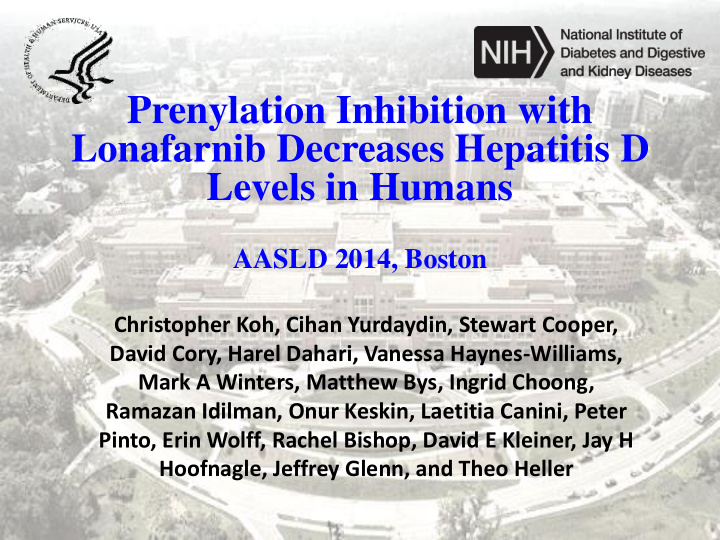



Prenylation Inhibition with Lonafarnib Decreases Hepatitis D Levels in Humans AASLD 2014, Boston Christopher Koh, Cihan Yurdaydin, Stewart Cooper, David Cory, Harel Dahari, Vanessa Haynes-Williams, Mark A Winters, Matthew Bys, Ingrid Choong, Ramazan Idilman, Onur Keskin, Laetitia Canini, Peter Pinto, Erin Wolff, Rachel Bishop, David E Kleiner, Jay H Hoofnagle, Jeffrey Glenn, and Theo Heller
Introduction • 15-20 million people are infected worldwide with HDV • Up to 80% of patients with HDV may develop cirrhosis within 5-10 years • Higher risk for hepatic decompensation leading to death & development of HCC compared to mono-infected patients Hughes SA, et al. Lancet 2011;378; Colombo M et al. Gastroenterol 1983; 85 Manesis EK et al. J Hep 2013;59; Fattovich G et al. Gut 2000; 46 Romeo R, et al. Gastroenterol 2009; 136
The Quest For Better Therapies • Interferon therapy is unsatisfactory – <30% achieve HBsAg loss and become HDV RNA negative – Extended duration of therapy does not help • Nucleos/tide analogues are ineffective • Investigational Therapies – HBV/HDV NTCP receptor entry inhibitor – HDV prenylation inhibitor Lau DT, et al. Gastroenterol 1999;117 Wedemeyer H, et al. N Eng J Med 2011;27 Wedemeyer H, et al. Hepatology 2013;58 Heller T, et al. Aliment Pharmacol Ther 2014;40
Prenylation Inhibition in HDV • Prenylation inhibitors have demonstrated effectiveness against HDV in in vitro and in vivo models Bordier et al. J Clin Invest 2003;112 Einav S, Glenn JS. J Antimicrob Chemother 2003; 52 Bordier BB, et al. J Virol 2002; 76
NIH HDV Lonafarnib Study • Phase 2A, Double Blinded, Randomized, Placebo Controlled Study • Endpoints: – Therapeutic: Improvement in quantitative HDV RNA levels after 28 days of lonafarnib therapy – Safety: Ability to tolerate lonafarnib at the prescribed dose for 28 days.
NIH HDV Lonafarnib Study Design Group 1: Lonafarnib 100 mg BID, 6 Treatment : 2 Placebo 3 Eligibility 28 days of Therapy 6 Months Follow-up Evaluations Group 2: Lonafarnib 200 mg BID, 6 Treatment : 2 Placebo * 3 Eligibility 6 Months Follow-up 28 days of Therapy Evaluations *Group 1 Placebo patients offered open-label Lonafarnib 200 mg
HDV Lonafarnib Study Flow 8 Patients Not Enrolled 22 Patients with 4 HDV RNA Undetectable +HDVAb Screened 3 Did Not Complete PreTx Evaluation 1 with Hepatocellular Carcinoma 14 Patients with +HDV RNA Enrolled 6 Blinded 8 Patients Treatment Lonafarnib 100mg 2 Blinded BID Placebo 2 Open-Label Treatment 8 Patients 2 Blinded Lonafarnib 200 mg Placebo BID 4 Blinded Treatment
Patient Characteristics Feature Result Males 71% Median Age (range) 38 (29-61) Nucleoside Analogues 31% Race Caucasian 43% *No difference in baseline parameters between Asian 50% placebo and treatment African 7% groups Median Laboratory Results (IU/mL) ALT 89 AST 61 HDV RNA 1.01E+06 HBV DNA <21 Median Histology Ishak Fibrosis 3
HDV Decline During Therapy 0.5 Median HDV Decline From Placebo Baseline (log IU/mL) 100mg BID 0.0 200mg BID -0.5 -1.0 -1.5 -2.0 0 7 14 21 28 Day of Therapy
HDV RNA Decline After 28 Days of Therapy p=0.002 p=0.04 p=0.01 Log HDV RNA Decline 0.5 0.0 -0.13 -0.5 IU/mL -0.73 -1.0 -1.5 -1.54 -2.0 -2.5 Placebo 100mg BID 200mg BID Lonafarnib Dose
Correlation of Serum Drug Concentration and Change in HDV RNA Mean Change HDV RNA From Baseline to Day 28 (log IU/mL) 0.5 0.0 -0.5 r 2 =0.78 -1.0 -1.5 -2.0 -2.5 0 1000 2000 3000 Mean Serum Lonafarnib Concentration (ng/mL)
HDV Resistance Testing • Population-Based Sequencing of LDAg (codons 115-215) from Serum – Baseline – End of Therapy (Day 28) – End of Study (24 weeks post-therapy) • Lonafarnib 100 mg BID – Completed • Lonafarnib 200 mg BID – Baseline and End of Therapy (Day 28): Completed – End of Study (24 weeks post-therapy): Pending NO RESISTANCE SEEN
Symptoms & Side Effects Lonafarnib 100 mg BID Lonafarnib 200 mg BID Symptom Patients Symptom Patients Nausea 2 Nausea 6 Loose Stools 3 Diarrhea 6 Decreased Appetite 1 Anorexia 5 Abdominal Bloating 1 Dyspepsia 6 Vomiting 3 Weight Loss (mean) 6 (4 kg) No Subject Experienced a Grade 3 or 4 Adverse Event No Subject Experienced a Serious Adverse Event
Summary • After 28 days of therapy with lonafarnib, serum HDV RNA was significantly lower in both treatment groups compared to placebo • A dose dependent reduction in serum HDV RNA was seen with lonafarnib therapy • Serum lonafarnib concentrations correlate with HDV RNA decline
Summary • No HDV resistance was identified during population-based sequencing of LDAg • Lonafarnib was generally well tolerated at the prescribed doses for 28 days
Conclusion • This is the first demonstration that treatment of chronic HDV with the prenylation inhibitor lonafarnib significantly reduces virus levels in patients • The decline in virus levels significantly correlated with serum drug levels, providing further evidence for the efficacy of prenylation inhibition in chronic HDV
Future Directions • Single and Multi-National confirmation studies evaluating – Dosing – Duration – Efficacy
Acknowledgements Theo Heller David Cory Jay H Hoofnagle Ingrid C Choong Jake Liang Matthew Bys Vanessa Haynes-Williams Peter Pinto Rachel Bishop Erin Wolff Harel Dahari Laetitia Canini Jeffrey S Glenn Mark A Winters
Recommend
More recommend